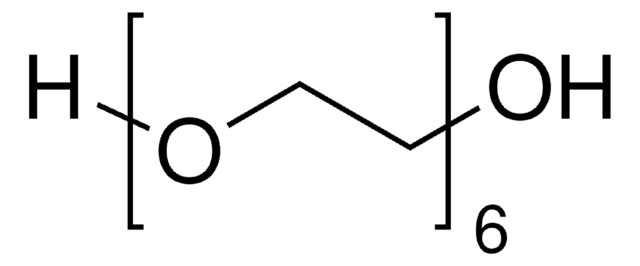689440
O-(2-Azidoethyl)heptaethylene glycol
≥95% (oligomer purity)
Sinonimo/i:
Azido-PEG (n=7)
About This Item
Prodotti consigliati
Saggio
≥95% (oligomer purity)
Stato
powder
PM
average Mn 400
Impiego in reazioni chimiche
reaction type: click chemistry
reagent type: cross-linking reagent
Estremità Ω
hydroxyl
Estremità α
azide
Gruppo funzionale
azide
hydroxyl
Temperatura di conservazione
2-8°C
Stringa SMILE
OCCOCCOCCOCCOCCOCCOCCOCCN=[N+]=[N-]
InChI
1S/C16H33N3O8/c17-19-18-1-3-21-5-7-23-9-11-25-13-15-27-16-14-26-12-10-24-8-6-22-4-2-20/h20H,1-16H2
BUMODEBRFGPXRM-UHFFFAOYSA-N
Applicazioni
Some of the reported applications include:
- Synthesis of strain-stiffening hydrogels through self-assembly of oligomers fibres derived from Azido-PEG (n=7).
- Synthesis of biodegradable tetra-PEG hydrogels for drug delivery system.
- Synthesis of heterobifunctional oligo(ethylene glycol) linkers for bioconjugation and targeted drug delivery.
- Preparation of synthetic amphiphiles for programmed pH-dependent dispersions of carbon nanotubes (CNTs).
- Selective glycoprotein detection through allosteric click-imprinting by using a self-assembled monolayer developed from the above oligomer.
- Preparation of bioactivated quantum dot micelles containing fluorescent nanocrystals.
Confezionamento
Avvertenze
Warning
Indicazioni di pericolo
Consigli di prudenza
Classi di pericolo
Eye Irrit. 2 - Skin Irrit. 2 - STOT SE 3
Organi bersaglio
Respiratory system
Codice della classe di stoccaggio
10 - Combustible liquids
Classe di pericolosità dell'acqua (WGK)
WGK 3
Punto d’infiammabilità (°F)
Not applicable
Punto d’infiammabilità (°C)
Not applicable
Dispositivi di protezione individuale
dust mask type N95 (US), Eyeshields, Gloves
Scegli una delle versioni più recenti:
Possiedi già questo prodotto?
I documenti relativi ai prodotti acquistati recentemente sono disponibili nell’Archivio dei documenti.
I clienti hanno visto anche
Articoli
Progress in biotechnology fields such as tissue engineering and drug delivery is accompanied by an increasing demand for diverse functional biomaterials. One class of biomaterials that has been the subject of intense research interest is hydrogels, because they closely mimic the natural environment of cells, both chemically and physically and therefore can be used as support to grow cells. This article specifically discusses poly(ethylene glycol) (PEG) hydrogels, which are good for biological applications because they do not generally elicit an immune response. PEGs offer a readily available, easy to modify polymer for widespread use in hydrogel fabrication, including 2D and 3D scaffold for tissue culture. The degradable linkages also enable a variety of applications for release of therapeutic agents.
Devising biomaterial scaffolds that are capable of recapitulating critical aspects of the complex extracellular nature of living tissues in a threedimensional (3D) fashion is a challenging requirement in the field of tissue engineering and regenerative medicine.
Il team dei nostri ricercatori vanta grande esperienza in tutte le aree della ricerca quali Life Science, scienza dei materiali, sintesi chimica, cromatografia, discipline analitiche, ecc..
Contatta l'Assistenza Tecnica.![2-[2-(2-Azidoethoxy)ethoxy]ethanol solution ~0.5 M in tert-butyl methyl ether](/deepweb/assets/sigmaaldrich/product/structures/374/007/eea7ca74-41e4-4aac-af71-c93c37ec0a5a/640/eea7ca74-41e4-4aac-af71-c93c37ec0a5a.png)




![2-[2-(2-Chloroethoxy)ethoxy]ethanol 96%](/deepweb/assets/sigmaaldrich/product/structures/902/295/ff6d7bb1-a7e0-4582-86e1-819084626e67/640/ff6d7bb1-a7e0-4582-86e1-819084626e67.png)






